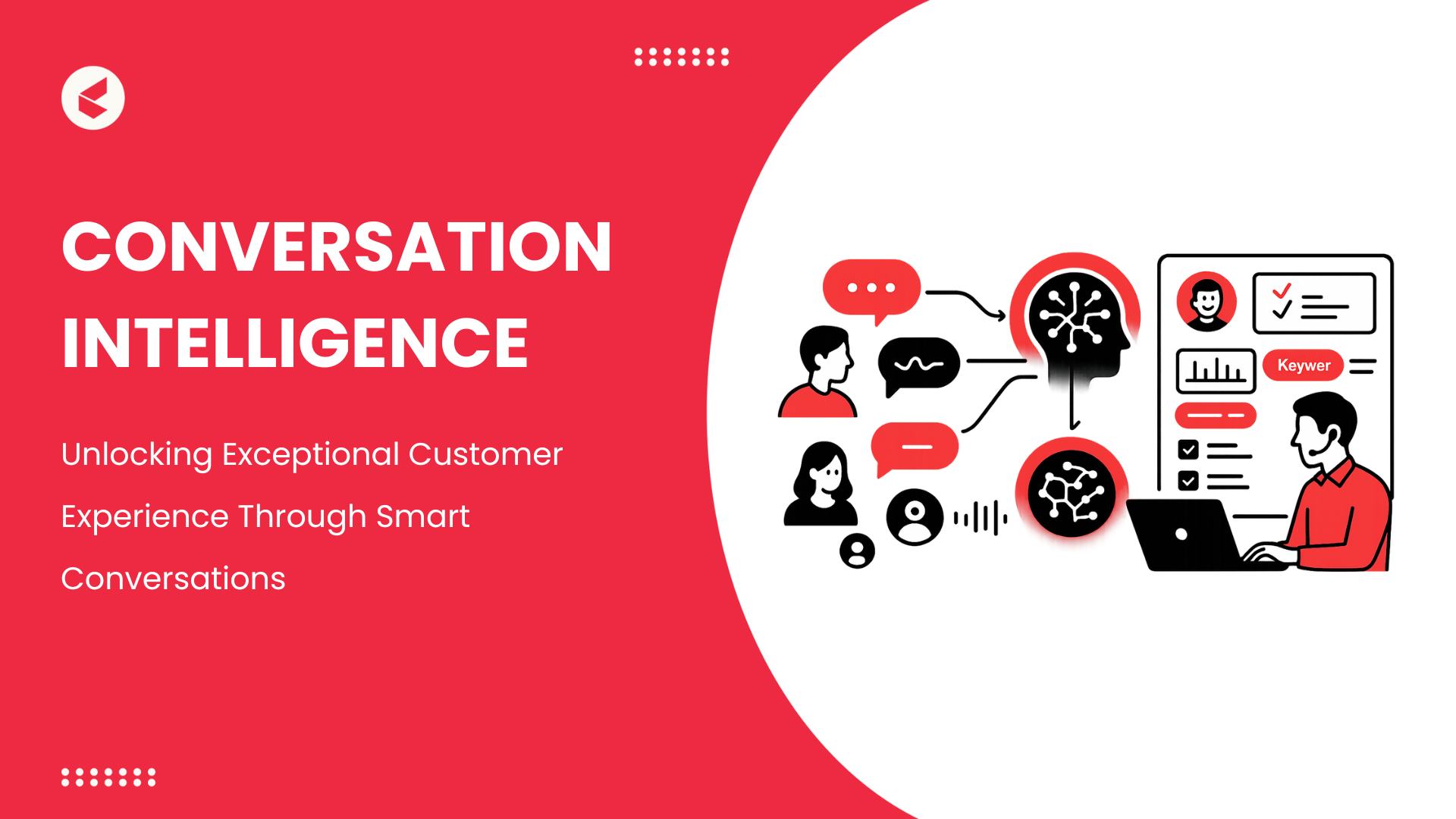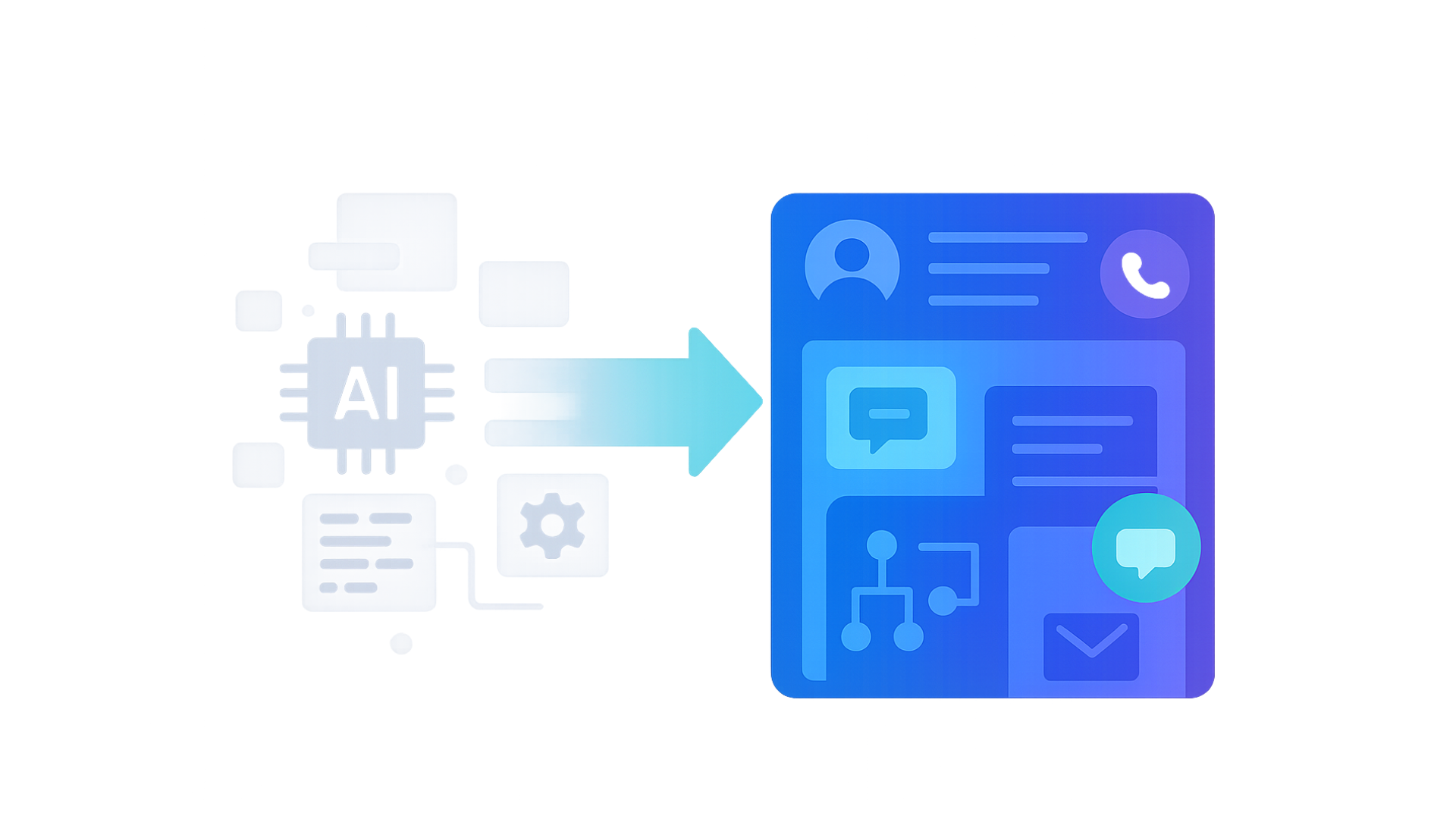An average contact center deals with thousands of calls every month. And, according to a Gartner study, this goes up 10x during holidays and promotional events. It means CX leaders are looking at hundreds of hours of call tracking data. Transcripts check for outliers, but spotting valuable insights is still tough.
However, conversation intelligence (CI) changes this equation. It stitches a unified, real-time view of customer interactions by employing advanced AI to analyze and interpret. Additionally, it works by laser-focusing on sentiment, intent, and context to offer personalized support.
As per FMI, the market for conversation intelligence software is expected to expand at a CAGR of 8.2% to reach USD 55.7 billion by 2035. These figures reflect a growing need for highly interactive support experiences. CI makes this possible by large-scale automation of the raw, unstructured customer data to CX insights. It leads to reduced average call handling time and a strong brand image.
Read on to learn about how conversation intelligence can be a boon to your CX team.
What Is Conversation Intelligence in Customer Experience?
Conversational intelligence is the practice of analyzing and deriving useful insights from support interactions using sophisticated AI-powered tools.
How does it work?
Conversations with customers across all possible channels are loaded with millions of conversations. CI software records these conversations. After that, it transcribes them and employs AI tools like ML and NLP to find –
- Key events
- Voice tone
- Word choice
- Customer sentiment
- Contextual significance
- Pain areas
Conversation intelligence helps enterprises hone their CX tactics by turning unstructured conversations into data-powered insights. The best part? It automates processes like sentiment analysis and follow-up activities for large-scale objective analysis. Results? Reduced bottlenecks and top-notch QA.
Some of the key functionalities of conversational intelligence are –
- Analyze call transcripts to pinpoint common customer pain points
- Use AI to detect sentiment shifts during customer interactions
- Provide real-time coaching based on live conversation cues
- Monitor customer feedback across multiple channels for a unified view
- Use conversation insights to automate follow-up actions
How Conversation Intelligence Improves CX Success?
We see our customers as guests to a party, and we are the hosts. It’s our job every day to make every important aspect of the customer experience a little bit better
~ Jeff Bezos, former CEO, Amazon
Modern CX is all about crafting memorable, effortless experiences. But support teams often work in silos. Each has its own view of the customer. Agent A closes a ticket, but Agent B takes over the next call without full context.
The tone of the customer sounds positive, but their words put the spotlight on previous unresolved concerns. Meanwhile, valuable insights hide in separate notes, unseen and unused. Results are fractured CX systems and disengaged customers.
So, how can organizations break through these barriers? Does sentiment analysis alone work?
It helps, but doesn’t suffice. Sentiment analysis can tell you if someone is upset or happy, but it does not tell you why or how to rectify the issue in real-time. Customers become frustrated when agents miss out on these nuances, and support teams feel exhausted trying to connect the dots.
This is where conversational intelligence stitches together every single interaction into a cohesive story. CI pays attention to your query. It analyzes the request and then offers actionable insights in real-time.
Alongside capturing the entire context, CI also makes quick recommendations for the best course of action. It spots subtle indications like reluctance or disorientation.
Basically, conversation intelligence is a smart co-pilot to your agents who know how customers feel, why they feel that way, and how to immediately improve their experience.
How Conversation Intelligence Software Works: Data to CX Insights
Here is how CI software works to mould raw customer datasets into strategic CX enhancements.
1. Data Ingestion and Transcription
The first step in the process is to record customer interactions across all possible channels.
For voice conversations, CI software employs ASR to convert spoken words into text. These neural network-based models are trained on large speech datasets to ensure high transcription accuracy even in difficult acoustic environments.
2. Text Processing with NLP
Once the information is transcribed, NLP is used. The data is set up for an in-depth analysis by
- Indicating the main points of the dialogue
- Tokenization splits the text into smaller units
- Lemmatization identifies the grammatical structure
3. Identify Intent and Entities
Next, entity recognition extracts key details such as product names, while intent detection algorithms determine what the customer wants. Transformer-based models trained on extensive datasets use context analysis to understand subtle cues and sarcasm in language correctly.
4. Evaluate Emotional Tone
Sentiment analysis examines the conversation’s emotional undertones. It provides quick insights into customer sentiment by training machine learning models on labeled data.
5. Find Patterns and Forecast Results
After that, the system uses conversation analytics to locate –
- Compliance problems
- Escalation touchpoints
- Micro-moments
It makes proactive support strategies possible by using predictive analytics to project customer satisfaction scores or churn risks based on past interaction patterns.
6. Convert Information into CX Insights
Customer support teams can then use these insights to optimize scripts and deliver personalized experiences.
Key Capabilities of Conversation Intelligence for CX & Service Teams
From fragmented CX to real-time answers, conversation intelligence works on millions of data points to detect patterns across silos. Here are the top capabilities that empower the smooth functioning of conversation intelligence.
1. Real-Time Analytics
CX teams can keep an eye on customer interactions as they occur, thanks to real-time data in CI platforms. In fact, this feature employs advanced algorithms and streaming data processing to evaluate conversations in real time.
CX reps receive an immediate notification when a customer starts showing frustration or when certain compliance keywords are detected. This quickness equips agents to change their strategy and de-escalate the situation.
2. Sentiment and Intent Analysis
Did you know that according to Gartner, 80% of businesses that employ NLP for sentiment analysis claim higher customer satisfaction? How?
Sentiment analysis uses NLP techniques like deep neural networks and transformer architectures. This helps to understand context and subtleties in language and the emotional tone of the customer.
Conversely, intent analysis focuses on the purpose of a support call. Is the customer asking for a refund? Do they need tech assistance, or are they terminating a service? These capabilities help to detect negative customer sentiments early on to minimize churn rates.
3. Call Summarization
Call summarization is an automated process that creates summaries of long discussions. The method is based on sequence-to-sequence models trained on a large collection of conversation data.
The outcome is an easy-to-understand summary that contains the main points of the interaction for quick resolution.
By implementing this CI function, support teams can transfer cases more quickly and maintain records more effectively, saving their time.
4. CRM Integration
Effective use of conversation data requires a seamless connection with CRM systems. IT equips support agents to instantly access customer interactions during real-time interactions by integrating CI insights into CRM solutions.
Moreover, it automatically updates customer profiles with new requests or changes in sentiment identified during interactions. To maintain the CRM as the only source of truth, AI conversation analytics uses middleware and APIs to synchronize data in real time.
5. Agent Coaching and QA
Did your agent fail to follow a script or miss an upsell opportunity? AI-powered platforms analyze each conversation thoroughly to flag instances where agents need improvement.
In such cases, automated scoring and feedback help provide targeted coaching to take service quality up a notch. This feature relies on ML models trained to recognize communication patterns and compliance adherence.
Key Benefits of Conversation Intelligence for CX Teams
Here is why conversation intelligence is the nerve center of modern CX.
1. Offers Real-Time Assistance for Agents
Contact centers face challenges while trying to strike a balance between quality and speed. In this scenario, conversation intelligence comes up as a vigilant co-pilot. Instead of waiting for after-action reviews or manual data retrieval, it provides instant prompts. It suggests responses and offers contextual insights during live interactions.
CI goes beyond reactive insights. It’s about shaping every moment of the conversation to be as helpful and efficient as possible.
2. Ensures Better First Call Resolution Rates
CI synthesizes every interaction in real time to uncover patterns and bottlenecks. This granular insight empowers CX teams to find the root causes of recurring issues and optimize workflows. Thus, it helps in increasing first call resolution rates.
For instance, Netmeds, a top pharmacy, has used conversation intelligence to create personalized workflows and provide omnichannel support. They achieved a 70% increase in FCR and a 50% decrease in AHT.
3. Scales Compliance Checks
In highly regulated industries like BFSI, it is mandatory to follow scripts and disclose specific information. Conversation intelligence can keep tabs on processes and signal you before any potential breach escalates.
Typically, QA for customer interactions is done manually on randomly selected calls. However, with CI tools, you can automate this process and test every single call for higher precision.
Use Cases of Conversation Intelligence Software in CX
Curious how conversation intelligence software can boost your CX? Let’s look at some real-world ways it helps teams connect better and solve problems faster.
1. Automated Issue Categorization
Instead of manually sifting through hours of transcripts, CI uses NLP models to classify issues on the fly. Retail giant like Shopify employs real-time categorization to flag product complaints or refund requests immediately. Agents get routed faster, and customers feel heard sooner.
This isn’t just about speed; it’s about precision. Automated tagging reduces misclassification, so your resolution path is spot on from the first touch.
2. Knowledge Gap Identification for Training
Ever wonder what your agents really need to level up? CI software reflects the gaps in your knowledge base and training programs. It finds recurrent queries or problems that your existing resources don’t answer by examining trends in thousands of chats.
For example, a fintech company can use CI analytics to identify where agents struggled with specific compliance queries. They then tailored training modules to boost first-call resolution rates.
Instead of guesswork, you get targeted content that elevates your frontline.
3. Personalized Customer Profiling
Forget one-size-fits-all! According to Hyken’s The State of Customer and CX study, 91% of customers would recommend a brand to their friends and family to go with businesses that offer personalized customer service. And, conversation intelligence software creates dynamic customer profiles based on
- Interaction history
- Sentiment
- Behavior cues
Think of a SaaS provider where every chat or call updates a rich profile in real-time. The technology determines if a customer prefers thorough explanations or speedy resolutions, then tailors interactions appropriately. The result? Improved CSAT and brand image.
4. Reducing Agent Onboarding Time
Getting new agents up to speed? Conversation intelligence accelerates onboarding in contact centers by providing real-time coaching and resource suggestions. When a new hire handles their first calls, CI highlights best practices and common pitfalls.
The Future of Conversation Intelligence in CX
So, the next big leap isn’t just smarter tech, but a whole new way of connecting with your customers. The following are the main new trends in conversation intelligence.
1. Contextual Emotional Awareness in Real-Time Dialogue Analysis
Future developments will allow conversational intelligence systems to analyze complex emotional states in real-time by taking into account –
- Context of the query
- Cultural background (local references in languages)
- Individual communication patterns
Besides detecting standard customer emotional states such as happiness or irritation, CI will also understand complex emotional signals, such as sarcasm or hesitancy. Such information will enable CX agents to interact with customers in a more empathic way.
2. Predictive Conversation Flow Optimization
Future CI systems will make use of micro-intent detection. It is the capacity to identify subtle cues in ongoing interactions that disclose a customer’s underlying requirements or potential future behaviors.
AI conversation analytics can anticipate a customer’s next move or the kind of information they might seek by examining pauses, tone changes, or particular linguistic patterns.
This predictive capability will optimize real-time conversation flow. It guides agents or automated systems to preemptively escalate issues at the optimal moment.
3. Cross-Channel Personalization
CI will be able to merge coherent, all-encompassing customer profiles in case of multi-channel support. This means fusion of conversational data with behavioral insights to create a holistic profile. Such a synthesis will enable hyper-personalized support based on the customer’s entire journey.
Why CX-First Organisations Can’t Afford to Ignore Conversation Intelligence?
Every conversation is a goldmine of insights if you know where to look. Conversation intelligence does exactly that by monitoring common customer pain points and FAQs. Typically, it is integrated straight into a CRM. In case you have a separate CRM, make sure it synchronizes with your CI tool to work on customer data seamlessly.
Looking for conversation intelligence solutions for CX? Turn conversations into strategic assets with Kapture CX. We mine every voice, chat, and email for deep AI insight to understand the needs of your customer.
Here are the top functionalities of our conversation intelligence tool –
- Continuous feedback loops – Retrains models on approved audits through ongoing feedback loops to improve scoring accuracy and lower false positives
- Role-Based Dashboards – Display the most up-to-date KPIs that are tailored for the different levels of management, like executives, supervisors, and agents, for quick action
- Mitigates breaches – Enforces a strict policy of no compliance breaches for abusive language or missed disclosures
- Single, searchable timeline – Integrates all the different sources of speech-to-text and data in a single place for easy comparison and auditing
- End-to-end encryption – Offers role-based access and GDPR-ready retention for customer data safety
- Multilingual, accent-tolerant engines – Automatically evaluate global conversations without the requirement of any add-on tools
Additionally, we offer TLS 1.2 for secure communication and PHI/PII masking to protect sensitive information .
Wish to boost resolution times? See how Kapture’s CI suite offers exceptional results at enterprise scale.
FAQs
No, conversational intelligence and conversational AI are different. Conversation intelligence is a layer of analytics that reviews past interactions to get insights and improve the service. Meanwhile, conversational AI is a tool, such as a chatbot, that talks to customers in real-time.
Focus on data privacy and simplified integration. Also, ensure your team is trained to use CI for generating insights. You can start with a pilot program to help you gauge ROI before full-scale deployment.
Many teams start noticing improvements in agent performance and customer satisfaction within a few weeks. However, the timing of results can vary across teams.













